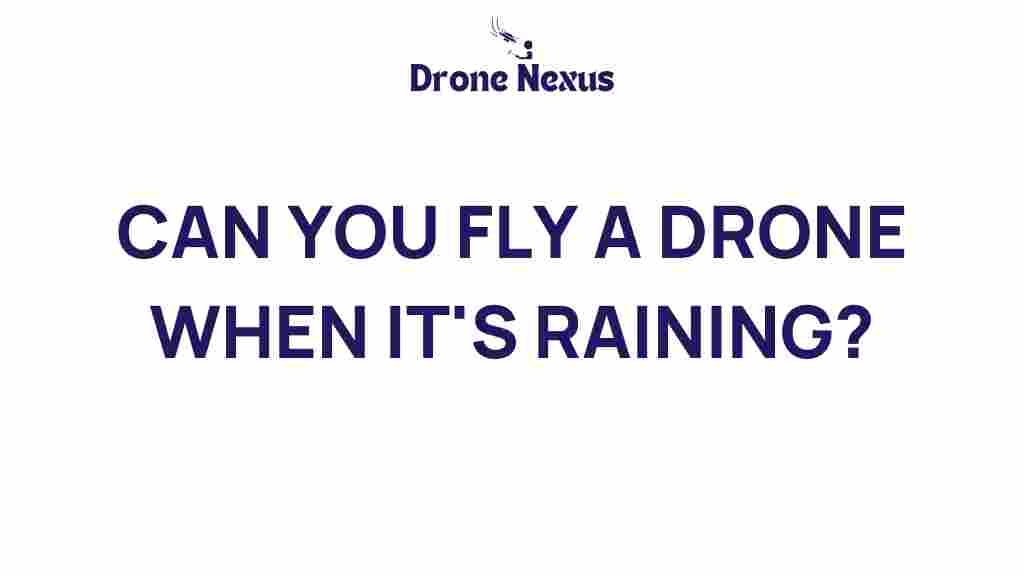Can You Fly a Drone When It’s Raining? Understanding the Risks of Drone Flying
As the popularity of drone flying increases, so do the questions surrounding the safety and legality of operating drones in various weather conditions. One common question is: Can you fly a drone when it’s raining? While it might be tempting to capture stunning footage during a rain shower, this decision comes with a set of risks that every drone operator should understand.
The Basics of Drone Flying in Rainy Weather
Before delving into the risks, it’s essential to understand the basic mechanics of drones and how they are affected by rain. Most consumer drones are not waterproof, meaning exposure to water can damage their electronic components. Here’s what you need to know:
- Waterproof vs. Water-Resistant: Many drones are classified as water-resistant, which means they can withstand minor moisture but are not designed for heavy rain.
- Impact on Flight Performance: Rain can affect the drone’s flight performance, including battery life, stability, and control.
- Visibility Issues: Rain can reduce visibility for both the drone and the pilot, making it difficult to maintain control.
Understanding the Risks of Drone Flying in Rain
When considering flying a drone in the rain, it’s crucial to assess the associated risks:
- Electronic Damage: Water can cause short circuits in the drone’s electronic components, potentially leading to malfunction.
- Reduced Battery Life: Cold and wet conditions can drain battery life faster, increasing the risk of losing control of your drone.
- Loss of Control: Rain can impact the drone’s sensors, making it harder to stabilize and navigate.
- Legal Implications: Depending on your location, flying a drone in adverse weather conditions may violate local regulations.
Step-by-Step Process: Assessing Conditions Before Drone Flying
Before deciding to fly your drone in the rain, follow these steps to evaluate the situation:
- Check Weather Reports: Always start by checking the local weather forecast. Look for precipitation levels and wind conditions.
- Assess Drone Specifications: Review your drone’s user manual to determine its weather resistance rating.
- Inspect the Drone: Ensure that all components, especially the battery and sensors, are in good condition and free from damage.
- Evaluate Visibility: Make sure visibility is adequate for safe operation. Fog and heavy rain can hinder your ability to see the drone.
- Consider Flight Time: Plan a shorter flight time to avoid battery issues and keep your drone within visual line of sight.
Tips for Safe Drone Flying in Rain
If you decide to proceed with drone flying in light rain, consider the following tips to minimize risks:
- Fly at Lower Altitudes: Keeping your drone closer to the ground can help you maintain control and visibility.
- Use a Protective Cover: Consider using a waterproof cover or bag designed for your drone to help protect it from moisture.
- Monitor Battery Levels: Keep a close eye on battery levels, as they may deplete faster in wet conditions.
- Limit Flight Time: To reduce the risk of damage, limit your flight time during rainy conditions.
- Stay Within Line of Sight: Always keep your drone within visual line of sight to ensure better control and safety.
Troubleshooting Common Issues during Drone Flying
Even with precautions, issues can arise when flying a drone in the rain. Here are some common problems and how to troubleshoot them:
1. Drone Loss of Control
If you notice that your drone is becoming unstable or unresponsive:
- Land Immediately: Bring the drone down safely as soon as possible to prevent crashes.
- Check for Water Accumulation: Inspect the drone for any visible water accumulation on the motors or sensors.
- Pause Flight: If conditions worsen, pause and wait for the rain to subside.
2. Reduced Battery Life
If your drone’s battery drains faster than usual:
- Return Home Early: If you notice rapid battery depletion, return home immediately.
- Check Battery Health: Ensure that your battery is healthy and fully charged before flying.
3. Navigation Issues
If your drone is having trouble maintaining its position:
- Adjust Settings: Calibrate the drone’s sensors and adjust flight modes if necessary.
- Consider Wind Conditions: Be aware of wind factors that may affect stability.
Legal Considerations for Drone Flying in Rain
Before flying your drone in rainy conditions, it’s crucial to understand the legal implications. Here are some points to consider:
- Local Regulations: Always check local regulations regarding drone flying in adverse weather conditions.
- Flight Restrictions: Some areas may have specific restrictions on flying drones in poor weather due to safety concerns.
- Insurance Policies: Review your insurance policy, as certain conditions may void coverage during adverse weather.
Conclusion: Is It Worth the Risk to Fly a Drone in the Rain?
In summary, while drone flying in light rain might be technically possible, the risks involved often outweigh the benefits. The potential for electronic damage, reduced battery life, and loss of control pose significant threats to both your drone and your safety.
Before making a decision, carefully assess the weather conditions, your drone’s specifications, and the legal implications of flying in rain. If you have any doubts, it’s always best to wait for clearer skies.
If you’re interested in learning more about drone flying regulations, check out this resource that covers essential guidelines and safety tips. For additional tips and advice on drone flying, feel free to visit our blog.
This article is in the category Safety and created by DroneNexus Team
